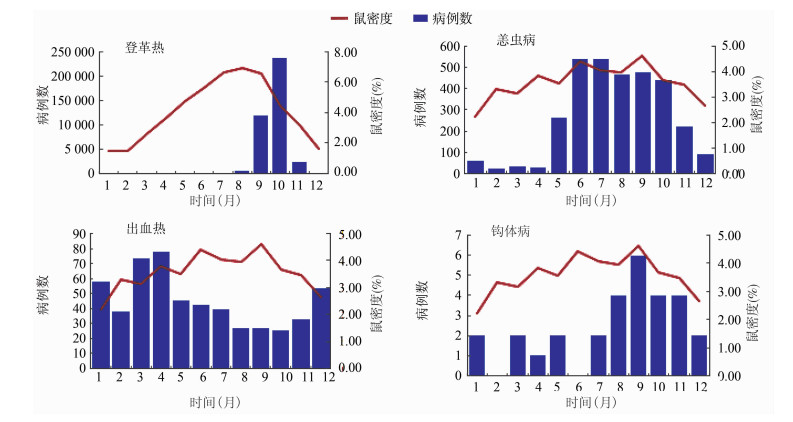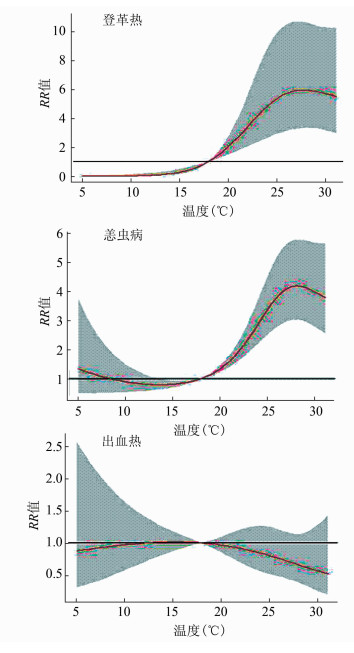扩展功能
文章信息
- 陈纯, 郑红英, 张周斌, 王大虎, 李铁钢, 王鸣
- CHEN Chun, ZHENG Hong-ying, ZHANG Zhou-bin, WANG Da-hu, LI Tie-gang, WANG Ming
- 气象因素对广州市虫媒传染病发病影响研究
- Influence of meteorological factors on arbo infectious diseases in Guangzhou
- 疾病监测, 2016, 31(12): 984-988
- Disease Surveillance, 2016, 31(12): 984-988
- 10.3784/j.issn.1003-9961.2016.12.004
-
文章历史
- 收稿日期:2016-04-30
近年地球气候持续变暖,为部分与疾病相关的虫媒和病原体创造了适宜的孳生环境,引起了多种传染病的发病和分布发生重大变化,加重对人群健康的危害[1-2]。特别是虫媒传染病,随着近年来全球各地自然灾害频繁发生,环境破坏严重,气象因素的变化以及跨国旅行、跨国劳务人员数量急剧攀升等影响,新病种不断发现,流行区域不断扩大,流行频率不断增强,成为防控的难点[3-5]。目前大多数学者的虫媒传染病研究方向主要集中在不同虫媒传染病流行现状综述、各地流行特征及不同影响因素对某一虫媒传染病影响的分析上[1-3, 5-8]。本研究尝试就近年来广州市主要气象因素对几类主要虫媒传染病发病情况的影响进行相关研究,以期对虫媒传染病的防控提供科学的参考依据。
1 资料与方法 1.1 资料来源法定传染病中虫媒相关的4种传染病登革热、恙虫病、流行性出血热(出血热)和钩端螺旋体(钩体)病2011-2014年广州市的病例数据通过中国疾病预防控制信息系统子系统“传染病报告信息管理系统”获得,本研究以发病日期为标准日期,日为基本单位进行发病数统计。2011-2014年每月平均气压、平均气温、平均相对湿度、降水量、平均风速和日照时数等气象资料从广州市气象局获得。2011-2014年广州市常住人口数从广州市统计局官网获取。
1.2 方法对发病资料和气象资料建立数据库,利用Excel 2003软件进行数据储存与基础统计,气象因素和发病数据应用SPSS 13.0软件和R软件进行Spearman单因素分析、泊松回归逐步法多因素分析和DLNM程序包进行气象因子与发病累积效应统计作图。
2 结果 2.1 流行特征分析2011-2014年广州市登革热、恙虫病、出血热和钩体病4种国家法定虫媒传染病合计报告病例42 554例,其中登革热、恙虫病呈现较明显的季节性分布,其他2种虫媒传染病呈现常年散发和周期性不明显的特征。2011-2014年广州市平均鼠密度为3.59%,6-9月较高;伊蚊幼虫平均密度[布雷图指数(BI)]为4.09,5-9月较高。2011-2014年4种虫媒传染病发病情况和蚊媒密度鼠密度每年和每月报告情况见表 1和图 1,各气象因子基本情况见表 2。
| 年份 | 登革热 | 恙虫病 | 出血热 | 钩体病 | |||||||
| 发病例数 | 发病率(/10万) | 发病例数 | 发病率(/10万) | 发病例数 | 发病率(/10万) | 发病例数 | 发病率(/10万) | ||||
| 2011 | 41 | 0.3 | 494 | 3.9 | 112 | 0.9 | 8 | 0.06 | |||
| 2012 | 154 | 1.2 | 940 | 7.3 | 134 | 1.0 | 12 | 0.09 | |||
| 2013 | 1 265 | 9.8 | 850 | 6.6 | 156 | 1.2 | 7 | 0.05 | |||
| 2014 | 37 359 | 285.6 | 878 | 6.7 | 142 | 1.1 | 2 | 0.02 | |||
| 合计 | 38 819 | 3162 | 544 | 29 | |||||||

|
| 图 1 2011-2014年广州市4种法定虫媒传染病发病及虫媒监测月分布 Figure 1 Monthly surveillance for 4 notifiable arbo infectious disease and insects in Guangzhou, 2011-2014 |
| |
| 气象因素 | 范围 | P25 | P50 | P75 | x±s |
| 平均气压(hPa) | 986.5~1020.0 | 999.2 | 1005.0 | 1010.0 | 1005.0±6.8 |
| 平均气温(℃) | 4.8~31.1 | 16.7 | 23.0 | 27.1 | 21.6±6.4 |
| 相对湿度(%) | 30.0~100.0 | 73.0 | 80.0 | 86.0 | 78.8±11.3 |
| 降水量(mm) | 0.0~136.4 | 0.0 | 0.0 | 2.5 | 5.3±13.6 |
| 平均风速(m/s) | 0.6~9.1 | 1.7 | 2.2 | 3.0 | 2.5±1.1 |
| 日照时数(h) | 0.0~11.8 | 0.2 | 4.5 | 8.1 | 4.5±3.8 |
对2011-2014年广州市4种国家法定的虫媒传染病日发病数据与发病同期平均气压、平均气温、平均相对湿度、降水量、平均风速和日照时数等6个气象因素进行Spearman相关分析。分析结果显示,气温、湿度、降水、风速和日照与登革热发病相关(P < 0.05);气压、气温、湿度、降水、风速和日照与恙虫病发病相关(P < 0.05);气温与出血热发病相关(P < 0.05);6个气象因素对钩体病的发病影响均较小(P>0.05),见表 3。
| 病种 | 平均气压 | 平均气温 | 相对湿度 | 降水量 | 平均风速 | 日照时数 | |
| 登革热 | r值 | -0.001 | 0.131 | -0.120 | -0.088 | -0.121 | 0.181 |
| P值 | 0.978 | 0.000 | 0.000 | 0.001 | 0.000 | 0.000 | |
| 恙虫病 | r值 | -0.511 | 0.592 | 0.067 | 0.072 | -0.186 | 0.282 |
| P值 | 0.000 | 0.000 | 0.010 | 0.006 | 0.000 | 0.000 | |
| 出血热 | r值 | 0.047 | -0.068 | 0.011 | 0.005 | 0.027 | -0.045 |
| P值 | 0.075 | 0.010 | 0.667 | 0.839 | 0.310 | 0.086 | |
| 钩体病 | r值 | -0.014 | 0.010 | -0.004 | 0.038 | 0.011 | 0.018 |
| P值 | 0.599 | 0.704 | 0.877 | 0.142 | 0.680 | 0.485 | |
运用泊松回归逐步法分别对各病种与6个气象因素在单因素分析中有统计学意义的因素进行多因素分析,结果显示,气温与登革热(RR=1.013)、恙虫病(RR=1.013)发病呈正相关,与出血热(RR=0.998)发病呈负相关;相对湿度与登革热(RR=0.916)发病呈负相关;降水量与登革热(RR=0.998)发病呈负相关;平均风速与登革热(RR=0.951)发病呈负相关;日照时数与登革热(RR=1.006)、恙虫病(RR=1.002)发病呈正相关,见表 4。
| 病种 | 逐步法后纳入因素 | 估计值 | Sx | z值 | P值 | RR值 | 95%CI下限 | 95%CI上限 |
| 登革热 | 平均气温 | 0.013 | 0.000 | 100.040 | < 0.01 | 1.013 | 1.013 | 1.013 |
| 平均相对湿度 | -0.087 | 0.001 | -119.250 | < 0.01 | 0.916 | 0.915 | 0.918 | |
| 降水量 | -0.002 | 0.000 | -21.210 | < 0.01 | 0.998 | 0.997 | 0.998 | |
| 平均风速 | -0.051 | 0.001 | -71.210 | < 0.01 | 0.951 | 0.949 | 0.952 | |
| 日照时数 | 0.006 | 0.000 | 27.760 | < 0.01 | 1.006 | 1.005 | 1.006 | |
| 恙虫病 | 平均气温 | 0.013 | 0.000 | 29.397 | < 0.01 | 1.013 | 1.012 | 1.014 |
| 日照时数 | 0.002 | 0.001 | 3.042 | < 0.01 | 1.002 | 1.001 | 1.003 | |
| 出血热 | 平均气温 | -0.002 | 0.001 | -3.169 | < 0.01 | 0.998 | 0.997 | 0.999 |
多因素分析结果显示,气温是多数病种的影响因素,进一步分析日平均气温对登革热、恙虫病和出血热发病的累积极端效应,日平均气温达到27.7 ℃时,登革热滞后0 d RR值最大,为5.95(95%CI:3.15~10.28);日平均气温为28.0 ℃时,恙虫病滞后5 d RR值最大,为4.20(95%CI:2.78~5.71);日平均气温为15.2 ℃时,出血热滞后10 d RR值最大,为1.00(95%CI:0.25~1.29),见图 2。

|
| 图 2 2011-2014年广州市日平均气温与登革热、恙虫病、出血热发病风险关联总效应图 Figure 2 Overall effect of daily mean air temperature on incidences of dengue fever, scrub typhus and hemorrhagic fever in Guangzhou, 2011-2014 |
| |
本研究发现气温是影响多数虫媒传染病传播发病的重要因素与相关文献研究结果一致[5-7]。本研究对广州市登革热、恙虫病、出血热和钩体病4种虫媒传染病近4年发病情况与发病同期气压、气温、湿度、降水、风速和日照6个气象因素分析研究表明,气象因素对不同类型的虫媒传染病发病影响各有差异,除钩体病发病受各气象因素影响均较弱外,气温、气压是影响多数虫媒传染病传播流行的主要气象因素,其中登革热和恙虫病的传播流行更易受到较多类型气象因素变化的影响。
白纹伊蚊及其他伊蚊是登革热的传播媒介,蔡松武等[9]对广东省蚊虫密度消长和种群构成研究的结果显示,广东省的优势蚊种是致倦库蚊(占89.9%),其次是白纹伊蚊(占5.9%),且从2008-2012年致倦库蚊逐年下降而白纹伊蚊逐年上升,可能也是近年来广州市登革热流行、病例多发的原因之一。广州市登革热传播和发病与气温、湿度、降雨、日照、风速等因素相关,与易彬樘等[10]研究结果一致。Cheng等[11]对2014年广州市登革热大暴发进行传播动力学研究结果显示,疫情早期的输入性病例传播、5-8月的强降水和高温导致蚊媒密度的增加等都是2014年广州市登革热疫情严重的重要因素。恙虫病、出血热和钩体病是以鼠类为主要传染源的自然疫源性疾病。恙螨是恙虫病的传播媒介[12],南方地区恙虫病的流行类型主要为夏季型6-8月[12]。本研究结果显示近年来广州市恙虫病6-10月多发,发病受到温度、降水量和日照等因素影响,与Li等[13]研究结果一致。2011-2014年,广州市平均鼠密度为3.6%,褐家鼠是主要优势鼠种,多数出血热病例为外来打工人群,与外来人口居住和工作条件差,与鼠类接触机会多有关[14-15]。吴荣军等[16]对连云港市赣榆县出血热与气象因子相关性分析结果显示,该病只与气温呈显著负相关而对其他气象因子效应不明显,与本研究结果一致。鼠类的繁衍和活动与钩体病的发生关系较为密切,人与环境中污染的水接触是该病的主要感染方式[12]。黄荆鹏等[17]认为降水是影响钩体病发生的主要气象因素,特别是7月既是农忙季节降水又充沛,利于钩体病原的扩散并增加了农民耕作中接触疫水的机会。本研究各气象因素对钩体病的发病影响均较小,可能与广州市钩体病病例数较少以及普遍城市化进程有关。
虫媒传染病因其病原体、特异性传播媒介和动物储存宿主均存在于自然环境中而有别于其他类型的传染病,其传播与防控的特殊性在于无法仅通过对人类行为的改变而得到实现[6]。本研究对广州市主要气象因素在常见虫媒传染病发病情况影响方面的分析结果表明,气温和气压是影响多数虫媒传染病传播流行的主要气象因素,不同病种所受影响均有所区别。如登革热发病与气温、日照时数呈正相关,且当日平均气温达到27.7 ℃时RR值最大,同时还与相对湿度、降水量、平均风速呈负相关,以上研究结果可应用到工作中,如纳入登革热发病风险评估,或进一步计算各气象因素在登革热发病影响中的危险值范围,进而对登革热发病进行气象因素风险值预警等。本研究仅从广州地区部分气象因素对几类常见的虫媒传染病发病影响进行初步分析,以期探索一定的规律和方法,为下一步利用气象因素对虫媒传染病进行发病风险预警与评估,与实际防控工作相结合打下一定基础。
作者贡献:
陈纯 ORCID:0000-0001-8336-8844
郑红英 ORCID:0000-0001-9035-933X
陈纯:负责对气象数据与病种数据进行统计分析和论文撰写
郑红英:负责对虫媒监测数据进行归类和整理
张周斌:对虫媒传染病防控工作提供指导
王大虎:参与部分虫媒传染病现场防控和数据收集工作
李铁钢:指导论文整体架构建立与撰写指导工作
王鸣:提供论文整体思路和论文写作指导与修改工作
| [1] | Zheng XL. Effects of global climate change on natural foci and vectors of infectious diseases[J]. Journal of Pathogen Biology, 2011, 6 (5) : 384–387. (in Chinese) 郑学礼. 全球气候变化与自然疫源性、虫媒传染病[J]. 中国病原生物学杂志, 2011, 6 (5) : 384–387. |
| [2] | Graham RW, Grimm EC. Effects of global climate change on the patterns of terrestrial biological communities[J]. Trends Ecol Evol, 1990, 5 (9) : 289–292. DOI:10.1016/0169-5347(90)90083-P |
| [3] | Qu B, Huang DS, Guo HQ, et al. Research of relation between the meteorological factors and arbo infectious disease[J]. Chinese Journal of Vector Biology and Control, 2005, 16 (6) : 450–452. (in Chinese) 曲波, 黄德生, 郭海强, 等. 气象因素与两种虫媒传染病关系的探讨[J]. 中国媒介生物学及控制杂志, 2005, 16 (6) : 450–452. |
| [4] | Wang JQ. Monitoring and analysis on imported insect-borne infectious diseases at Beijing port[J]. Chinese Journal of Frontier Health and Quarantine, 2014, 37 (5) : 292–293, 298. (in Chinese) 王俊侨. 北京口岸输入性虫媒传染病监测与分析[J]. 中国国境卫生检疫杂志, 2014, 37 (5) : 292–293, 298. |
| [5] | Li WG, Zhao M. Epidemic situation of arthropod-borne infectious diseases[J]. Infectious Disease Information, 2011, 24 (1) : 8–11. (in Chinese) 李文刚, 赵敏. 虫媒传染病流行现状[J]. 传染病信息, 2011, 24 (1) : 8–11. |
| [6] | Tang JQ. Natural focal disease[M]. Beijing: Science Press, 2005 : 3 -8. (in Chinese) 唐家琪. 自然疫源性疾病[M]. 北京: 科学出版社, 2005 : 3 -8. |
| [7] | Tong SL, Lyu Y. Global climate change and infectious disease[J]. Chinese Journal of Disease Control and Prevention, 2000, 4 (1) : 17–19. (in Chinese) 童世庐, 吕莹. 全球气候变化与传染病[J]. 疾病控制杂志, 2000, 4 (1) : 17–19. |
| [8] | Zheng XL, Luo L. Research progress on flavivirus susceptibility in Aedes aegypti[J]. Acta Parasitology et Medica Entomologica Sinica, 2010, 17 (1) : 47–54. (in Chinese) 郑学礼, 罗雷. 埃及伊蚊对重要黄病毒易感性研究概况[J]. 寄生虫与医学昆虫学报, 2010, 17 (1) : 47–54. |
| [9] | Cai SW, Duan JH, Liu WH, et al. Density fluctuation and population composition of mosquitoes in Guangdong province[J]. Chinese Journal of Hygienic Insecticides and Equipments, 2014, 20 (4) : 357–359, 362. (in Chinese) 蔡松武, 段金花, 刘文华, 等. 广东省蚊虫密度消长及种群构成分析[J]. 中华卫生杀虫药械, 2014, 20 (4) : 357–359, 362. |
| [10] | Yi BT, Zhang ZY, Xu DZ, et al. Correlation research of dengue fever epidemic and changing of climate factors in Guangdong province[J]. Chinese Journal of Disease Control and Prevention, 2002, 6 (Suppl 1) : 14–17. (in Chinese) 易彬樘, 张治英, 徐德忠, 等. 广东省登革热流行与气候因素变化的相互关系研究[J]. 疾病控制杂志, 2002, 6 (Suppl 1) : 14–17. |
| [11] | Cheng Q, Jing Q, Spear RC, et al. Climate and the timing of imported cases as determinants of the dengue outbreak in Guangzhou, 2014:evidence from a mathematical model[J]. PLoS Negl Trop Dis, 2016, 10 (2) : e0004417. DOI:10.1371/journal.pntd.0004417 |
| [12] | Li LJ, Ren H. Infectious diseases[M].8th ed. Beijing: People's Medical Publishing House, 2013 : 253 -254. (in Chinese) 李兰娟, 任红. 传染病学[M].8版. 北京: 人民卫生出版社, 2013 : 253 -254. |
| [13] | Li T, Yang Z, Dong Z, et al. Meteorological factors and risk of scrub typhus in Guangzhou, southern China, 2006-2012[J]. BMC Infect Dis, 2014, 14 : 139. DOI:10.1186/1471-2334-14-139 |
| [14] | Li CL, Hu ZG, Jiang YM, et al. Rodent population density and seasonal fluctuation in Guangzhou[J]. Chinese Journal of Hygienic Insecticides and Equipments, 2015, 21 (3) : 259–260, 264. (in Chinese) 李成玲, 胡志刚, 江毅民, 等. 广州市鼠类种群密度及季节消长趋势分析[J]. 中华卫生杀虫药械, 2015, 21 (3) : 259–260, 264. |
| [15] | Jing QL, Luo L, Xiao XC, et al. Surveillance on hemorrhagic fever with renal syndrome in Guangzhou, 2001-2010[J]. Journal of Tropical Medicine, 2012, 12 (1) : 15–18, 33. (in Chinese) 景钦隆, 罗雷, 肖新才, 等. 2001-2010年广州市肾综合征出血热监测分析[J]. 热带医学杂志, 2012, 12 (1) : 15–18, 33. |
| [16] | Wu RJ, Hu XS, Zheng YF, et al. The correlation analysis between hemorrhagic fever with renal syndrome (HFRS) and meteorological factors and forcast of HFRS[J]. Chinese Journal of Vector Biology and Control, 2005, 16 (2) : 118–120. (in Chinese) 吴荣军, 胡晓抒, 郑有飞, 等. 肾综合征出血热与气象因子相关性分析及其预报研究[J]. 中国媒介生物学及控制杂志, 2005, 16 (2) : 118–120. |
| [17] | Huang JP, Yan YW, Bao SF. Leptospirosis incidence relations with meteorological conditions[J]. Meteorology Journal of Hubei, 2000, 19 (1) : 25–26. (in Chinese) 黄荆鹏, 严有望, 包淑芳. 钩端螺旋体病发生率与气象条件的关系[J]. 湖北气象, 2000, 19 (1) : 25–26. |
 2016, Vol. 31
2016, Vol. 31


